When choosing an outdoor coating for the street, it is especially important that the material is durable, durable, wear-resistant, but at the same time beautiful. A win-win version that meets all the following requirements is a terrace board!
Characteristics and dimensions
Let's start with the description of the material:
Terraced board is one of the options for outdoor flooring. It is used not only for the design of the terraces, but also on the verandas, balconies, tracks, walkways, as well as in the facade of the facades of buildings, design of fences.
Important! Terrace are often confused with a deck board, but they are separate materials. It is easiest to distinguish in appearance: the first has a relief surface, the last is smooth.
Read also the pros and cons of sander
Characteristics of the board depend primarily on its composition: there is a terraced coating of natural wood or wood-polymer composite.
The advantages of each option and which of the two are best suitable for open and closed rooms we will analyze in the following sections.
As for the dimensions:
A terrace board of DPK is manufactured by a width of 9-25 cm, 3-6 meters long. Thickness varies depending on the purpose: thin - 19-21 mm, the average 22-30, fat - 35-48 (for places with high passability).
With an array of wood, everything is more complicated. Width in the range of 12-14 cm, length up to 4 m, thickness of boards ~ 28 mm.
The composition affects the service life of the terrace board: Decing DPK from different manufacturers has different parameters, but mostly the lifetime of the flooring reaches 50 years. Natural tree, unlike composite, regularly requires special processing: the more carefully perform it, the longer the coating will live.
Also, the service life depends on the wood breed: most often the board is made from larch and pine. The first (velveteen) without protective compositions will serve ~ 50 years, the second is not more than 5.
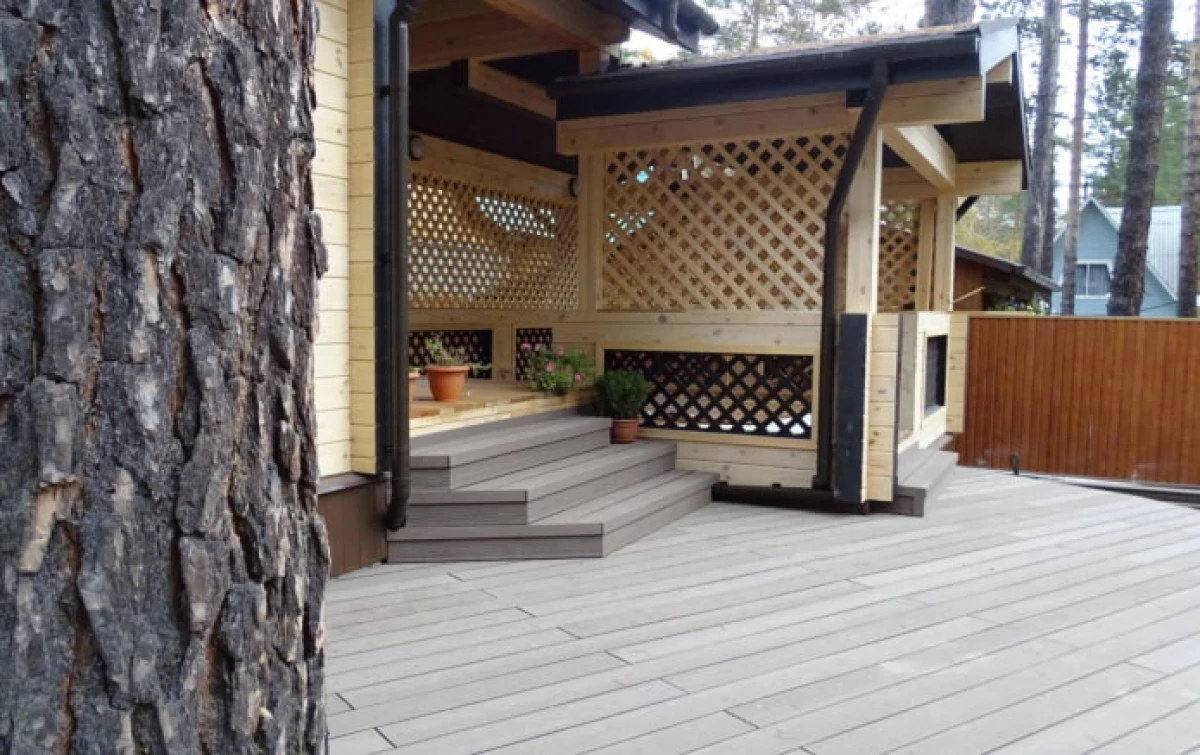
On the photo decoration of the terrace of Decing
Pros and cons
Which terraced plaque pluses and cons by most part depends on what it consists of. But first we will analyze general figures:
Read also examples of the landscape design of the country area
Benefits:
Moisture resistance. The board of DPK is not afraid of water in principle, the tree becomes hydrophobic after processing the surface of the board of protection.
Resistance to temperature drops. It concerns composite terraced coatings or expensive wood breeds. Cheap tree quickly loses appearance.
Wear resistance. Neither thin hairpins nor heavy furniture nor other aggressive measures can damage the finish.
Safety. Since slipping on the lags, thanks to the grooves on the corrugated surface, it is impossible, they are often a rack on the pixels, pirs, by the pools.
Durability. Life expectancy with active operation reaches 50 years and even more.
Beauty. Still, the floor, although street, should be not only practical, but also fit into the design. And what could be harmonious in the exterior than a tree or imitation?
The shortcomings of the terraced board are still logical to disassemble separately for wood and composite.
Any, even rare exotic wood species are exposed to moisture, mold, fungus, pests, insects. Therefore, flooring from wood requires protection. The boards are treated not only before laying, but also regularly repeat the coating on the ready-half. Without a varnish or wax from snow, rain, ultraviolet, lagows will quickly lose the original appearance and a given geometry: the flooring will have to be changed.
DPK terraced boards are deprived of the minuses listed above, but they have their own nuances: for example, an unnatural composition. Polyvinyl chloride overlaps a lot of flaws, but the eco-friendly flooring can no longer call.
Important! When counting the final cost of the finished floor, consider not only the price of the material, but also additional costs. For example, that the polymer decoping can be aesthetically complemented by G-or F-shaped profiles around the edges. And natural wood will have to be covered with special mixtures in several layers, and it also costs money. In addition, the work takes a lot of strength, time. Do not forget about fasteners - from self-samples to special fasteners.
What kind of material is better?
It is clear to unambiguously choose between a terrace board made of array or products from DPK difficult: both options have their advantages and disadvantages. Therefore, the decision is made on the basis of each specific case.
Natural tree
Read also ideas for creating comfort at the cottage.
By purchasing whole wooden materials, you add ecology to your space, but be prepared for complex preparation, regular care. Lags require periodic coating with oil, paint, varnish - only so you can achieve high performance.
The second question is the cost. Cheap larch or pine will not hit the budget, but it does not differ in high resistance to various kinds of influences and will serve not as long as, for example, an expensive oak.
The rule is simple: the harder the raw materials, the more expensive and more durable.
Wood is sold both clean and pre-treated:
Hem treated. Thanks to the steam sauna at a temperature of 200 ° C, the parameters of the tree are changed for the better: Decing becomes more durable, not affected by the ray rays.
Imprigised. In this case, the tree begins to absorb protective compositions already in production, and they penetrate into high-pressure fibers, which is much more reliable than the usual impregnation. In addition, during the complex process, wood under the influence of a vacuum loses excess moisture and becomes less susceptible to rotting, fungus.

In the photo Natural floorboard on a closed balcony
DPK.
Composite boards are deprived of a set of negative qualities of wooden materials, due to the addition of various polymers to the wood flour. PVC (it is used in the production of panels) ensures high humidity resistance, low temperature, sunlight.
Preparing a terraced board to laying is not required - lags are already painted and ready to use. Further care for the polymer floor is also minimal: withstands washing any means, does not need to be processed.
However, inexpensive unnatural compounds do not call: the cost of one board is on average twice as more than lamellae from coniferous rocks.
The ratio of polymers to wood flour determines more accurate decoction characteristics:
50/50. The mixture is considered the most correct - ready-made lags at the same time look and possess all the above positive qualities.
40/60. When PVC is more than a tree, the flooring looks very unfulstly.
70/30. On the one hand, a small amount of polymer = more eco-friendly composition. On the other hand, less protection against moisture - the floor can wake up.

In the photo, a fine-fucked composite
Recommendations for choosing
The use of a terrace board is the main point on which the final choice should be founded.
Read also how to equip a country gazebo?
For example, for closed arbors, balconies, loggias are better to choose a larch or other coniferous analogue. Cheap breeds are not as strong, so do not better behave outdoors. But in the room they do not have equal: first, the squares of the balconies are small and the processing will have little. Secondly, a beautiful structure and a characteristic smell of wood will create an unforgettable atmosphere in the house.
Open loggias, verandas, terraces or porches are bright with high-quality expensive boards (differ in durability, density) or a decoprian of a wood-polymer composite. The second can highlight an unpleasant smell in closed rooms, but in open areas is safe.
What else to pay attention when choosing a terrace board:
Class. Applies to natural wood, shows the quality of raw materials. For example, AB is inexpensive, but there are bitch on the surface. Extra is the best type of boards: absolutely smooth, homogeneous wood.
Color. Natural field can be coated with any composition, and the composite shade is set by the manufacturer and selects "on the shore".
Appearance. Of course, there should be no cracks on the front side, chipping.
Standard. Materials made of polymer composite can be marked HOME (used for low-load spaces), Professional (has increased strength, suitable for commercial locations).
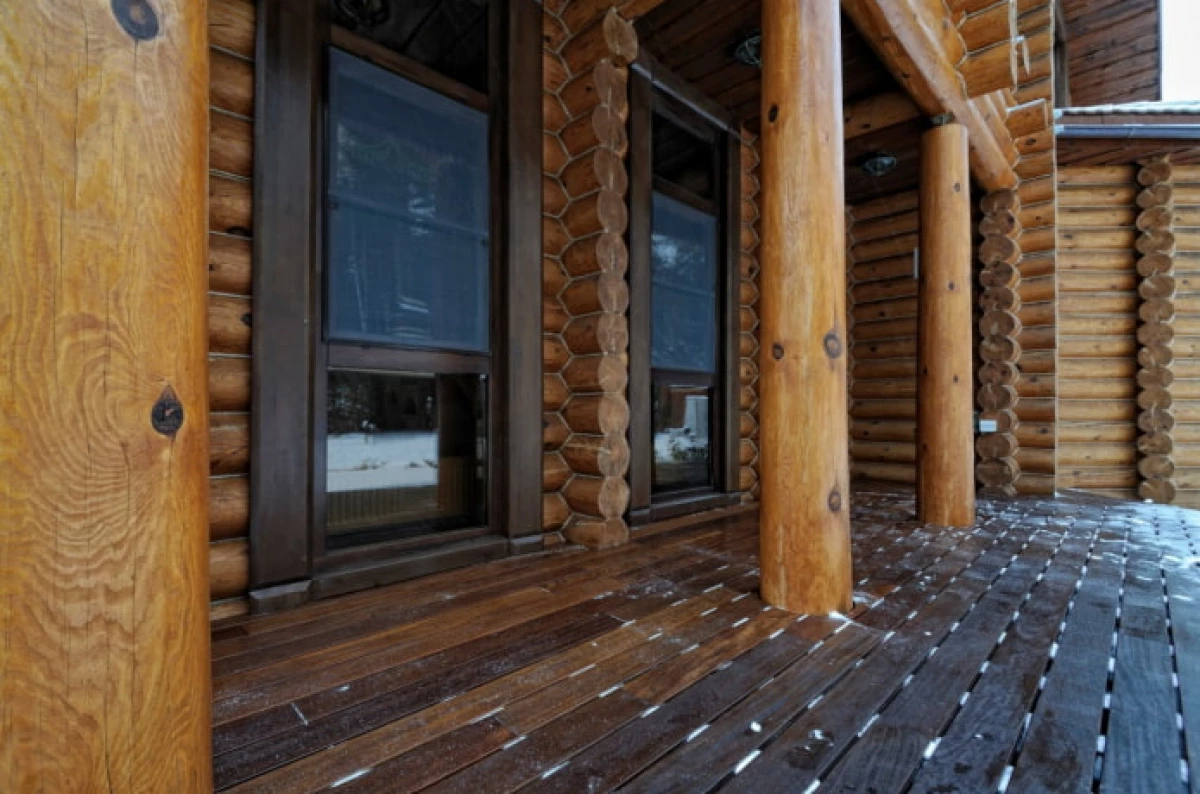
In the photo Dark floor on the porch at home
Application options
Thanks to practically unique properties, terraced lags were so loved by masters that they were already where they just did not use: from internal works in apartments, to the finishing of facades of houses and installation of fences.
Paul on the balcony
Floor finish for open or cold-type balconies, causes many questions based on materials: not all species are suitable for balcony conditions. The terrace board is a suitable option for flooring, because walking barefoot on it is one pleasure.
Yes, and the installation process is so simple that with the stacking you can cope with your own hands - and therefore, the high price is justified by savings on the payment of masters.
Tip! Lags are suitable not only for floor decoration, but also walls, ceilings.
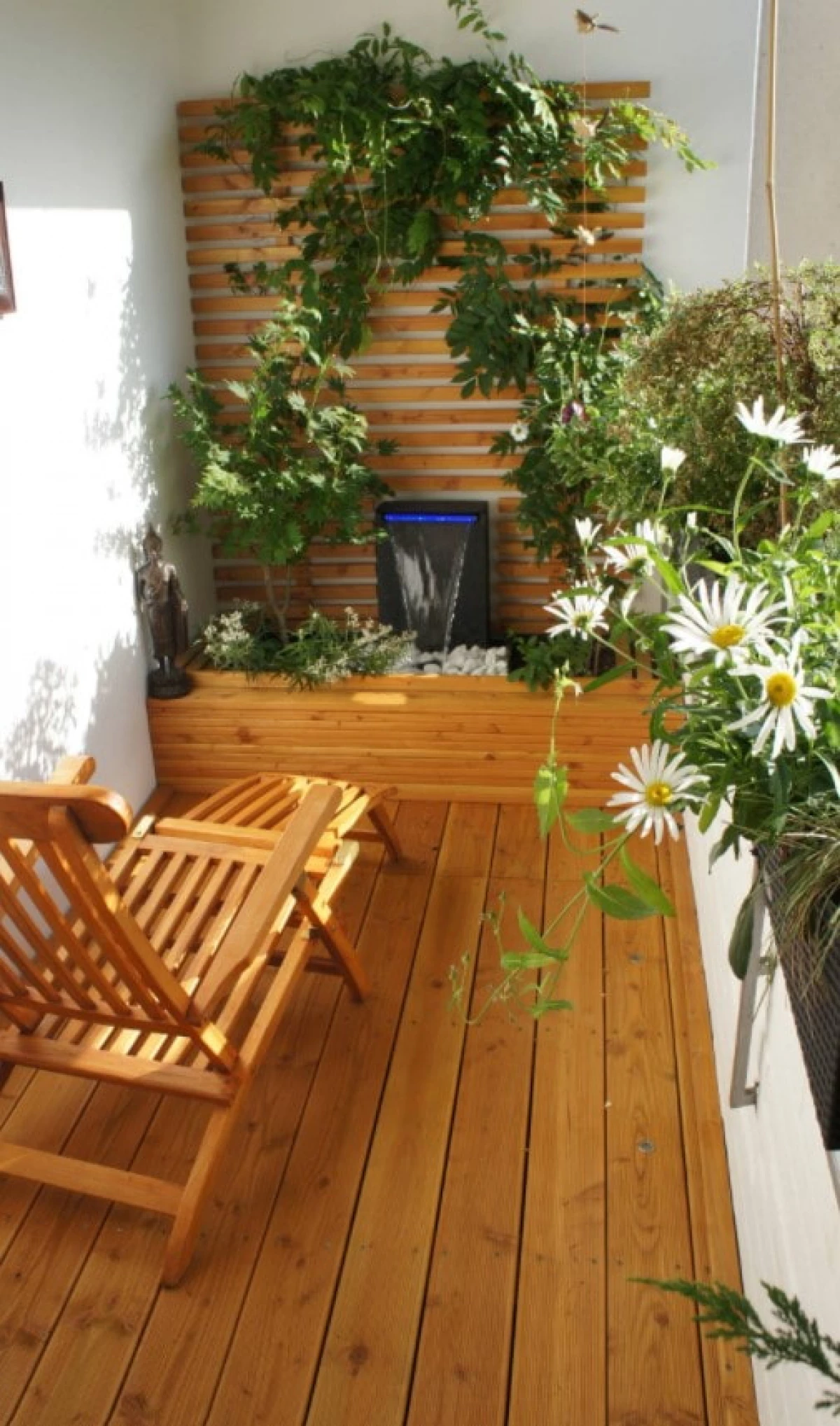
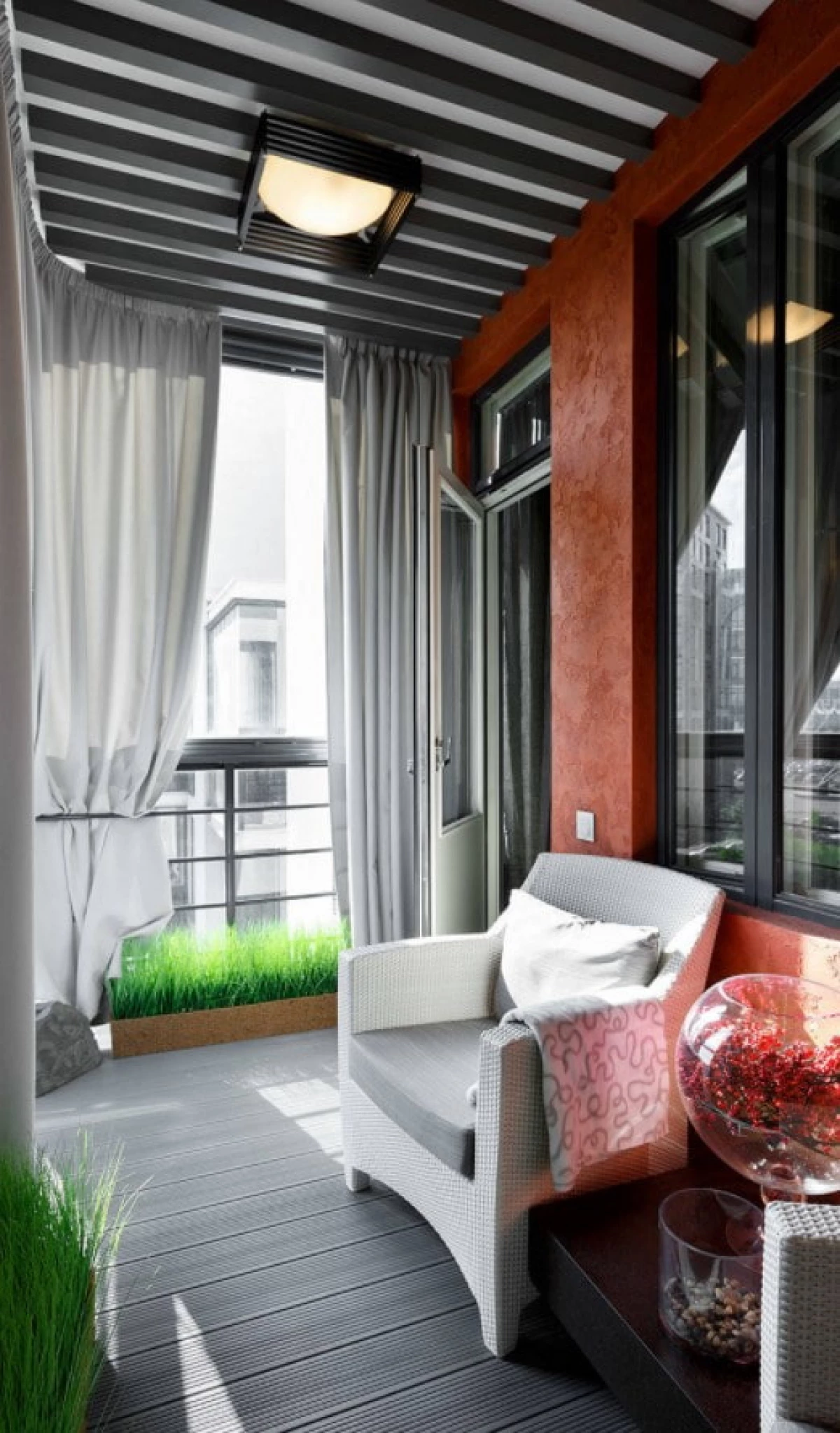
Paul on terrace
By the name it is easy to guess that the terraced board is literally created for the terraces! Sun-resistant, temperature, humidity The coating perfectly fits into the landscape design and creates a cozy atmosphere near the house.
On such a floor, you can place a seating area, a dining area, put a jacuzzi or pool, install a playground.
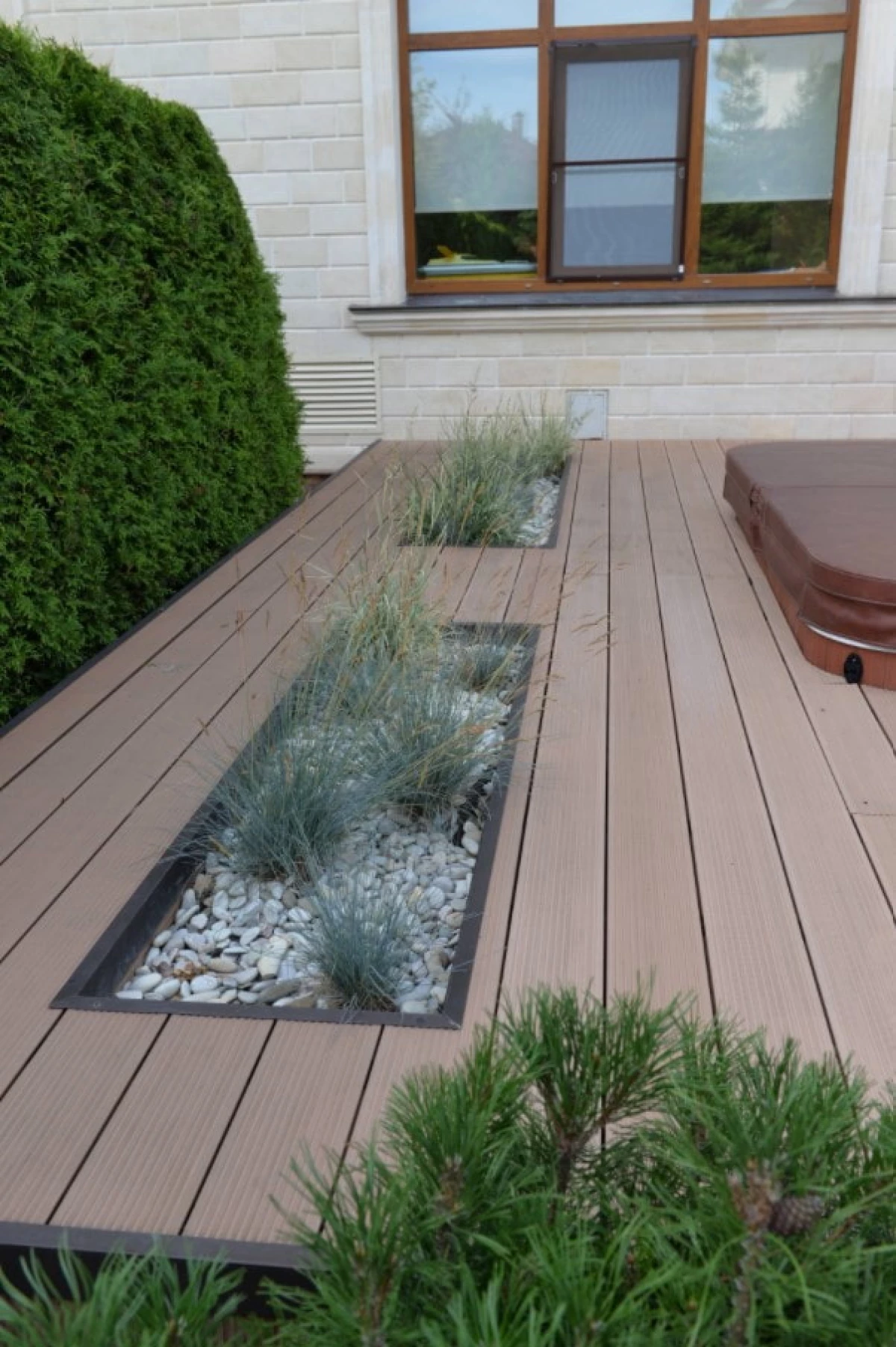
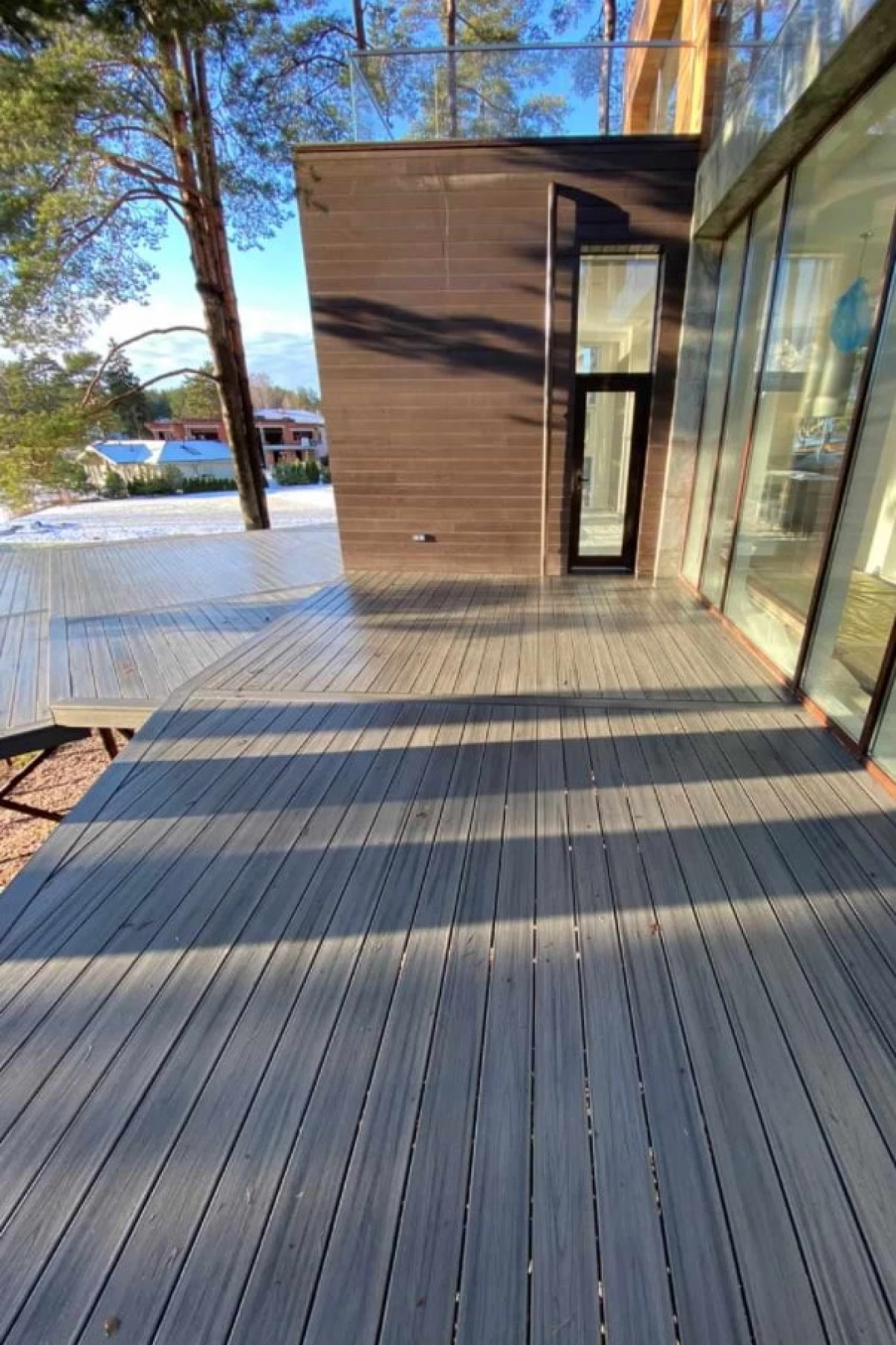
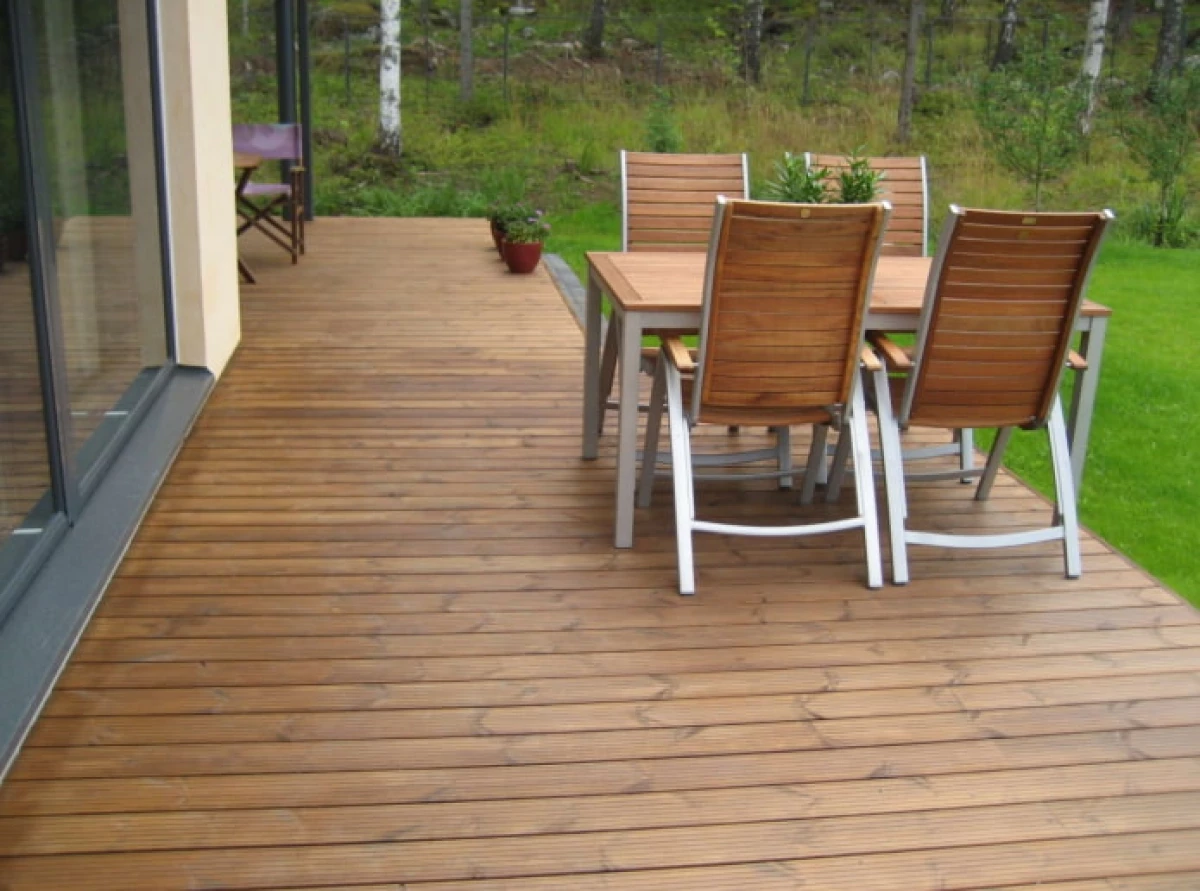
On the photo Open terrace with a dining table
Finishing the porch
The entrance door site is subjected to serious mechanical loads, so the requirements of the floor here are the requirements higher than even on the terrace. Flooring should be decorative, wear-resistant - such as a terraced board.
In addition, the porch is often equipped with steps, which should be safe for children and adults: Slipping on the wooden floor is excluded even after the rain in the fall or snowfall in winter.
Tip! If the rains often come in your region - shield a porch deing. The texture of the surface and gaps between the boards will not give water to accumulate at the entrance to the house or penetrate inside.

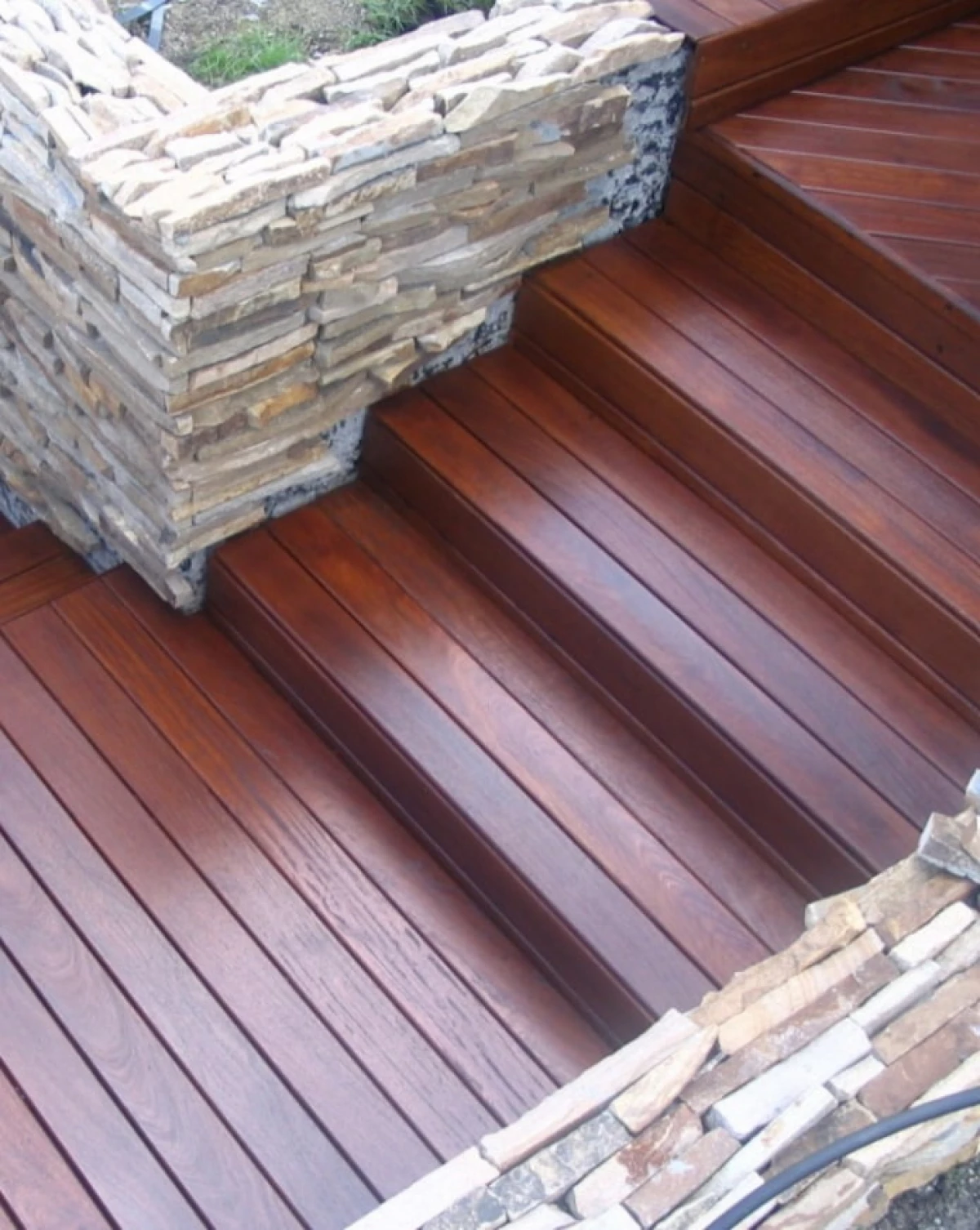
Tracks in the country
The most important component of landscape design are garden paths. They directly affect the appearance of the site, because they diverge throughout the perimeter.
Terraced board - Excellent option for troping. The tree successfully fits into the environment, and it is so simple to wash it, unlike the same stone, it is much easier: it means your paths will always look aesthetic.


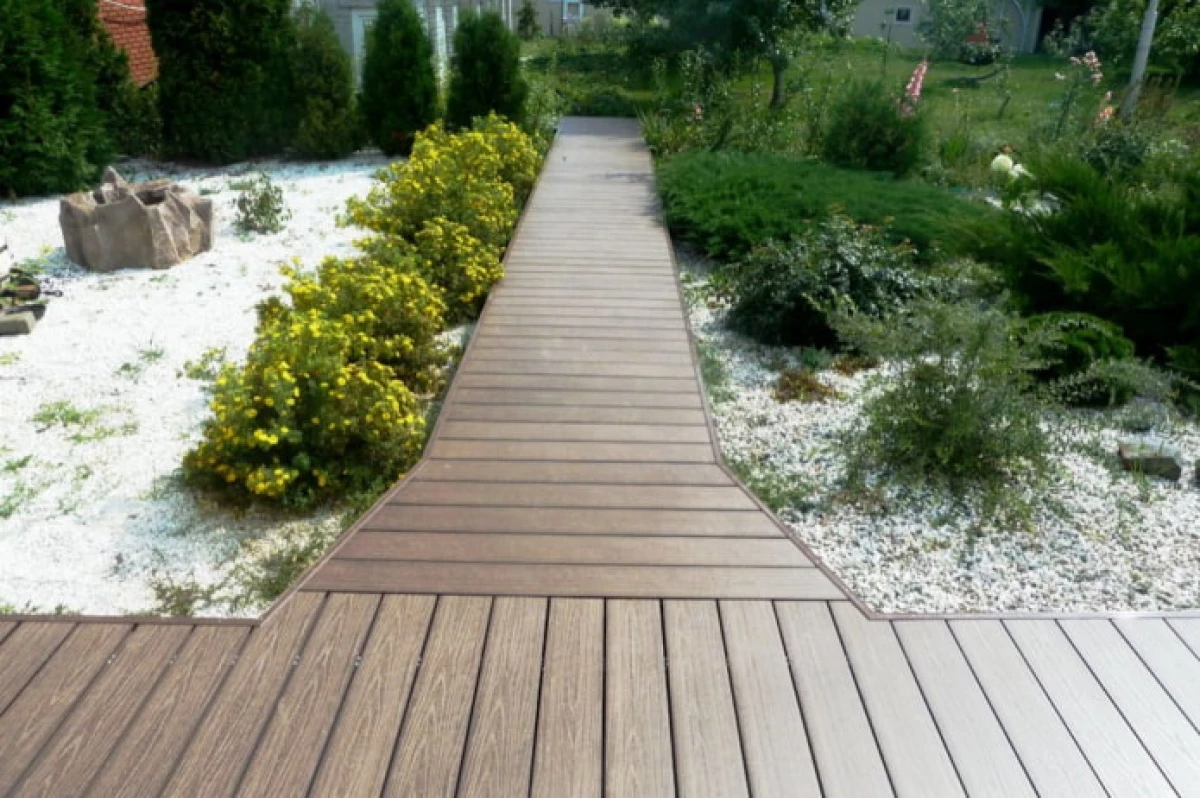
In the photo of the path in landscape design
Facades
Any varieties of the terrace board are an option of an analogue of lining or siding. In such "clothes", private homes and cottages look modern, original.
Important! For a more spectacular appearance, use lags only on parts of the house, combining them with simpler, smooth materials - for example, plaster.
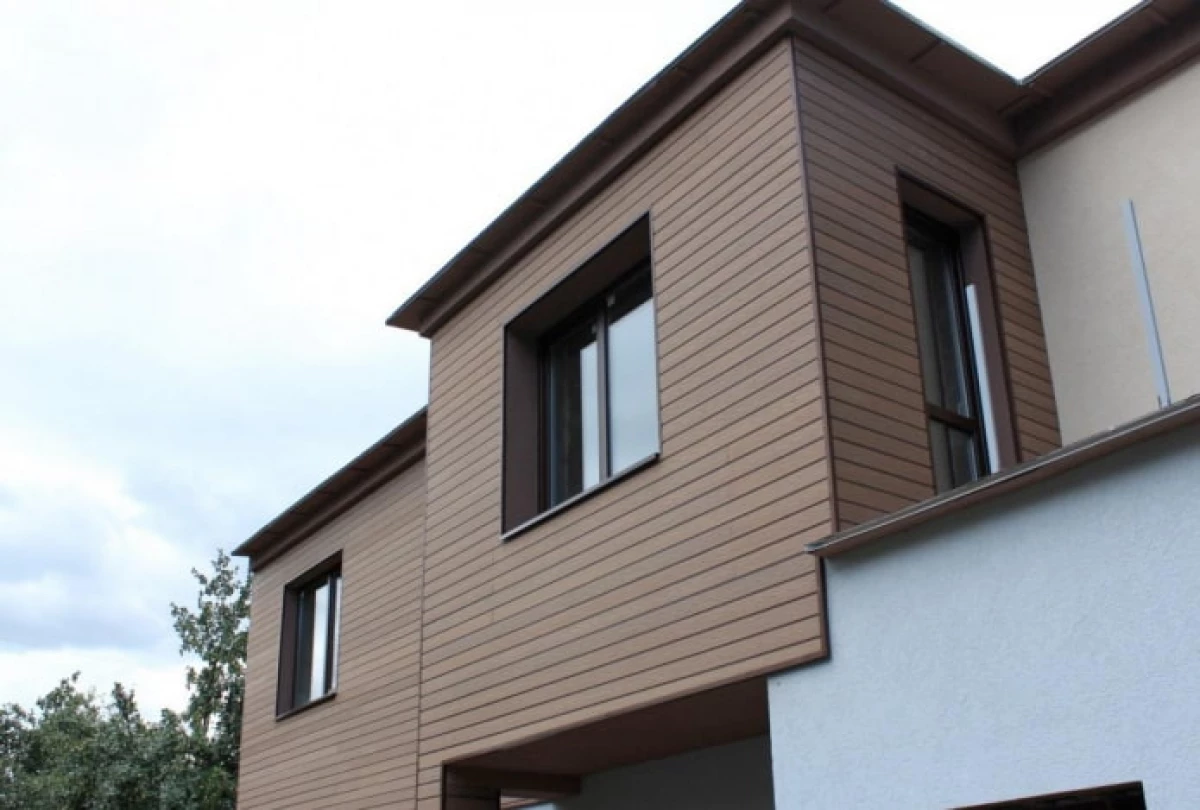
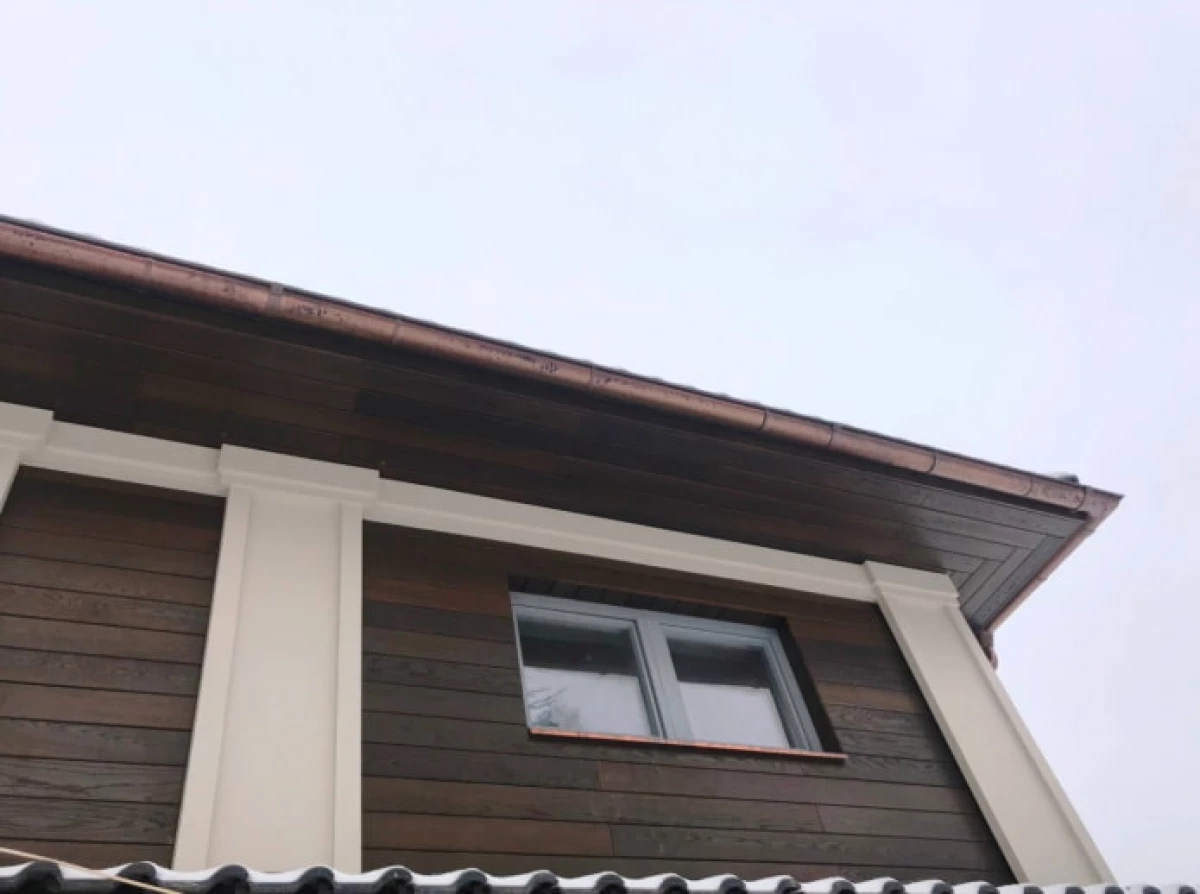
Selection of terraced boards
Suitable lamellas and for the construction of fences: Safe swelling from Decing have a pleasant appearance and raise the status of the object.
From individual boards, you can make a classic stakenik around the house, a horizontal fence or a popular "wave-like" laying recently (the manufacturer is better entrusted to the construction company).
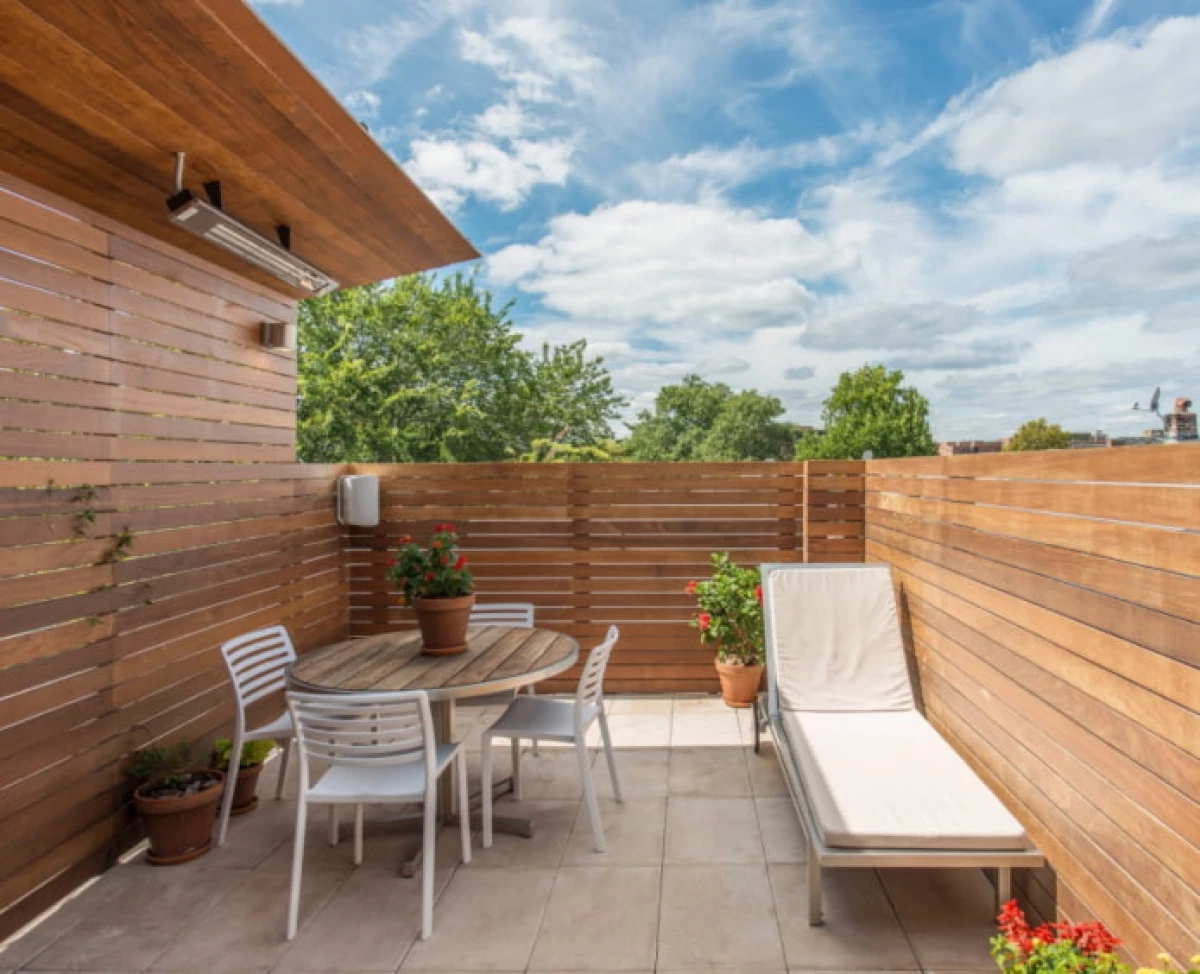

Gate of a terrace board
In addition to the fence, you can make the gate and gate: for this, individual planks are fastened with self-draws on a metal profile of any type.
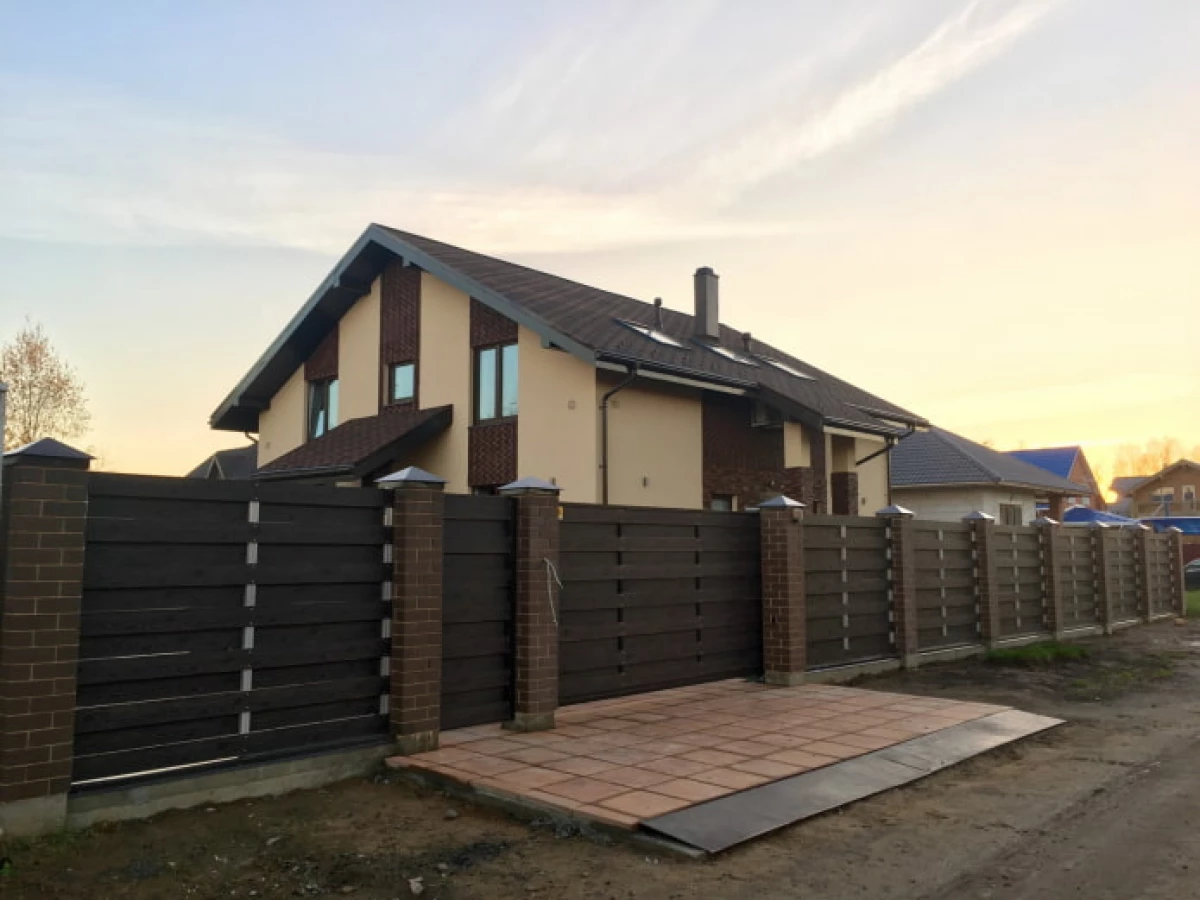
In the photo, the combined fence from the board and brick
Grocery
It is impossible to leave without attention and avid dachens. The high degree of protection against water lags made from DPK allows you to use them as tribes for beds. The garden with such flower beds looks very stylish.
Depending on the task, you can make a bed of any shape, dimensions: from low little flower beds for flowers, to a huge "porridge" for a tree or shrub.
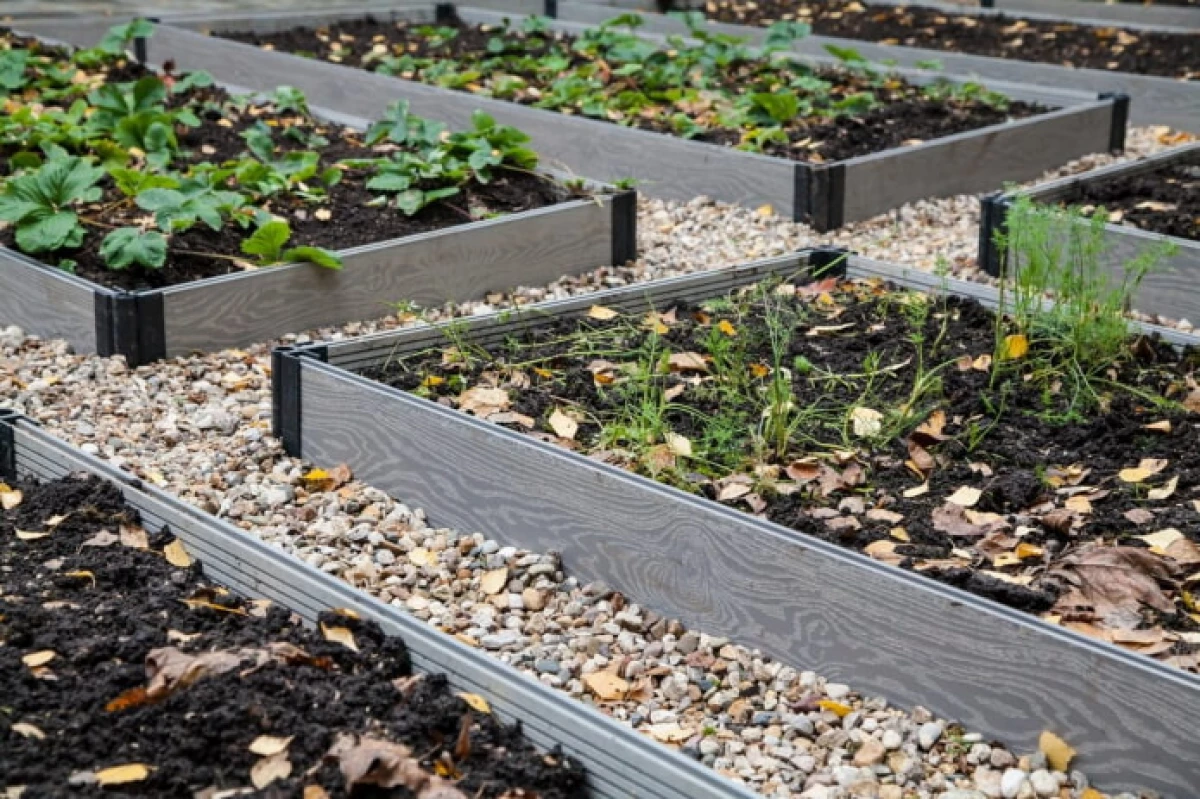
In the photo of the beds from Deconga
Examples of design
The main question when choosing boards - color. PVC Decing is available in a wide palette of shades: from natural, kind of oak, maple, pine.
Until unusual:
Gray quartz;
green malachite;
Red-orange terracotta;
SERO-black indigo.
In different manufacturers, various color rules, in some cases, if there is not enough diversity, you can ask to make the desired shade under the order by selecting the RAL scale.
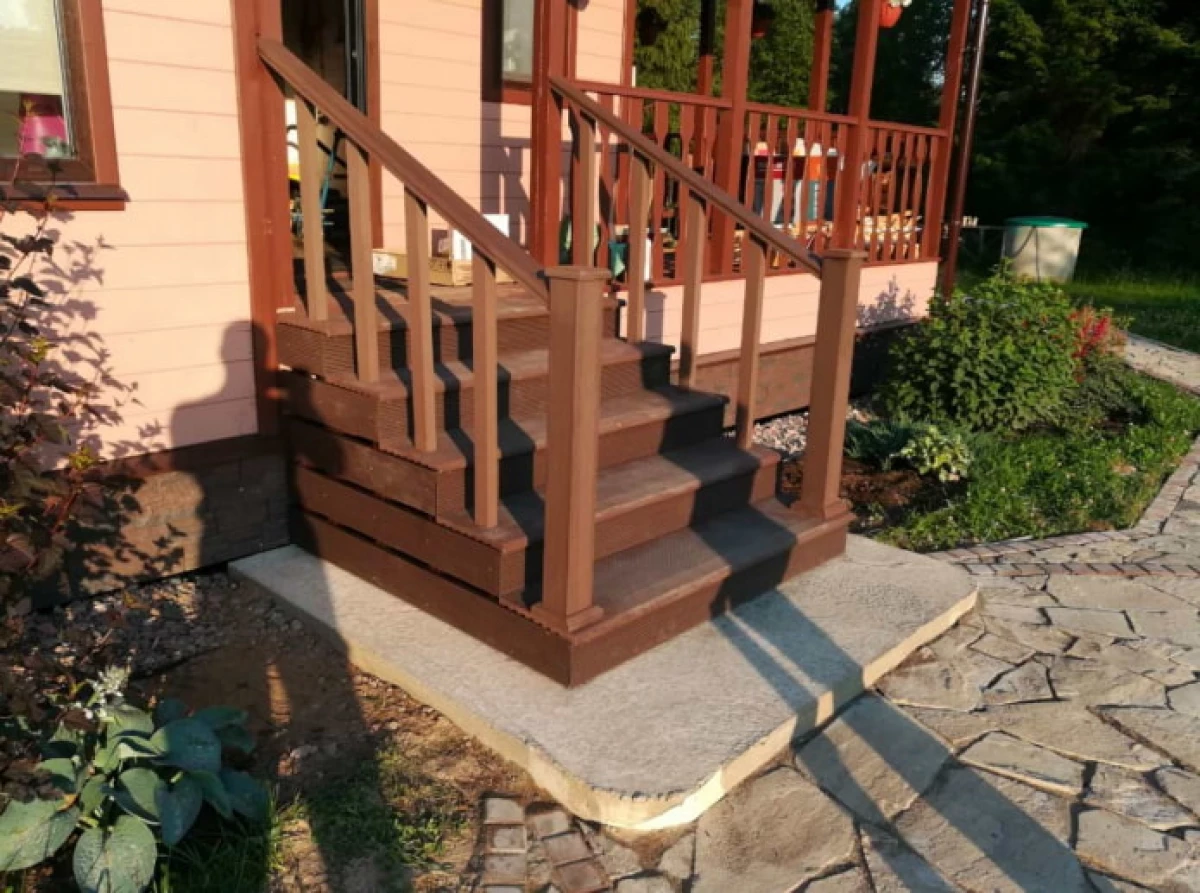
In the photo Finishing Stairs Decing from DPK
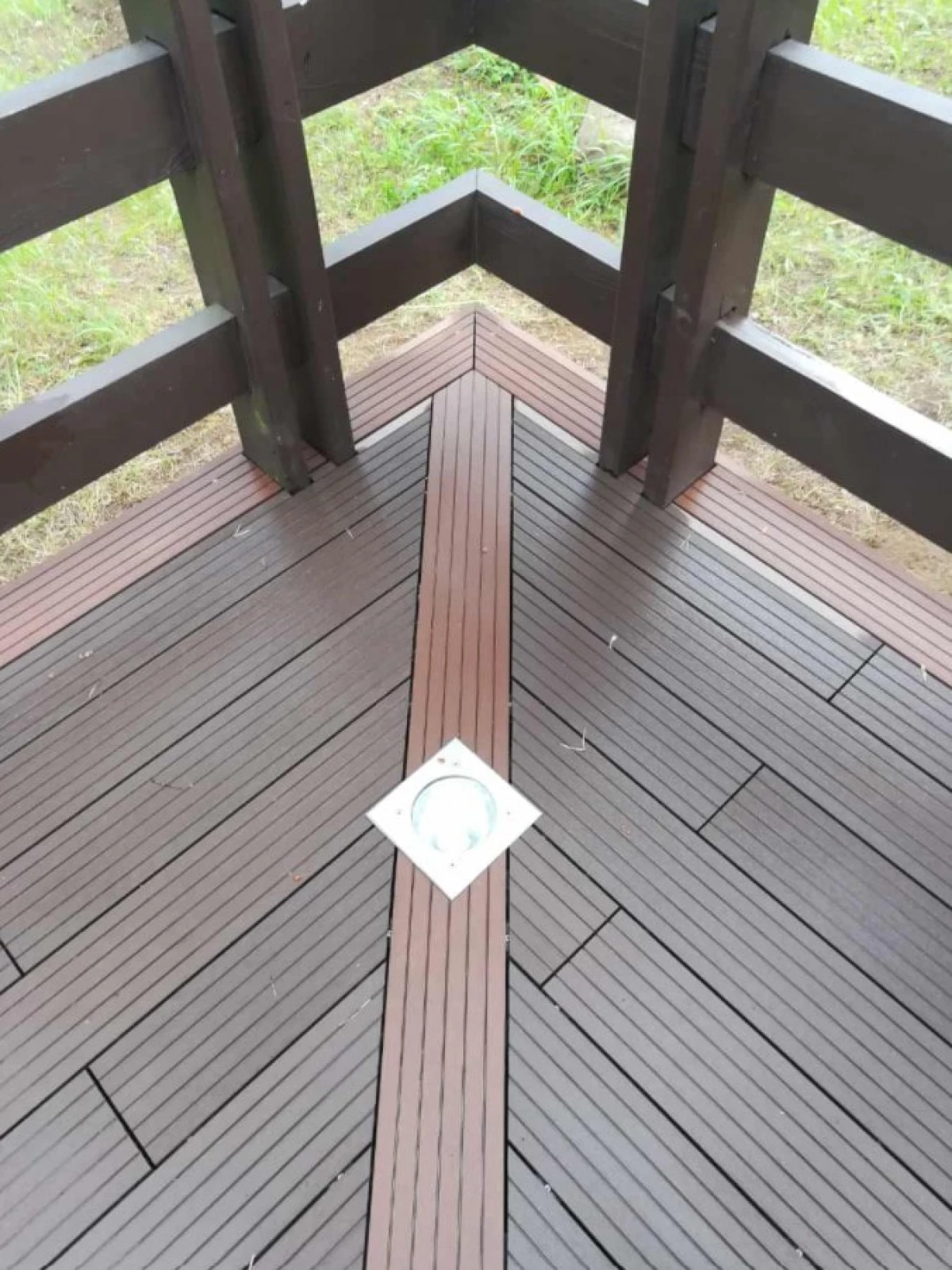
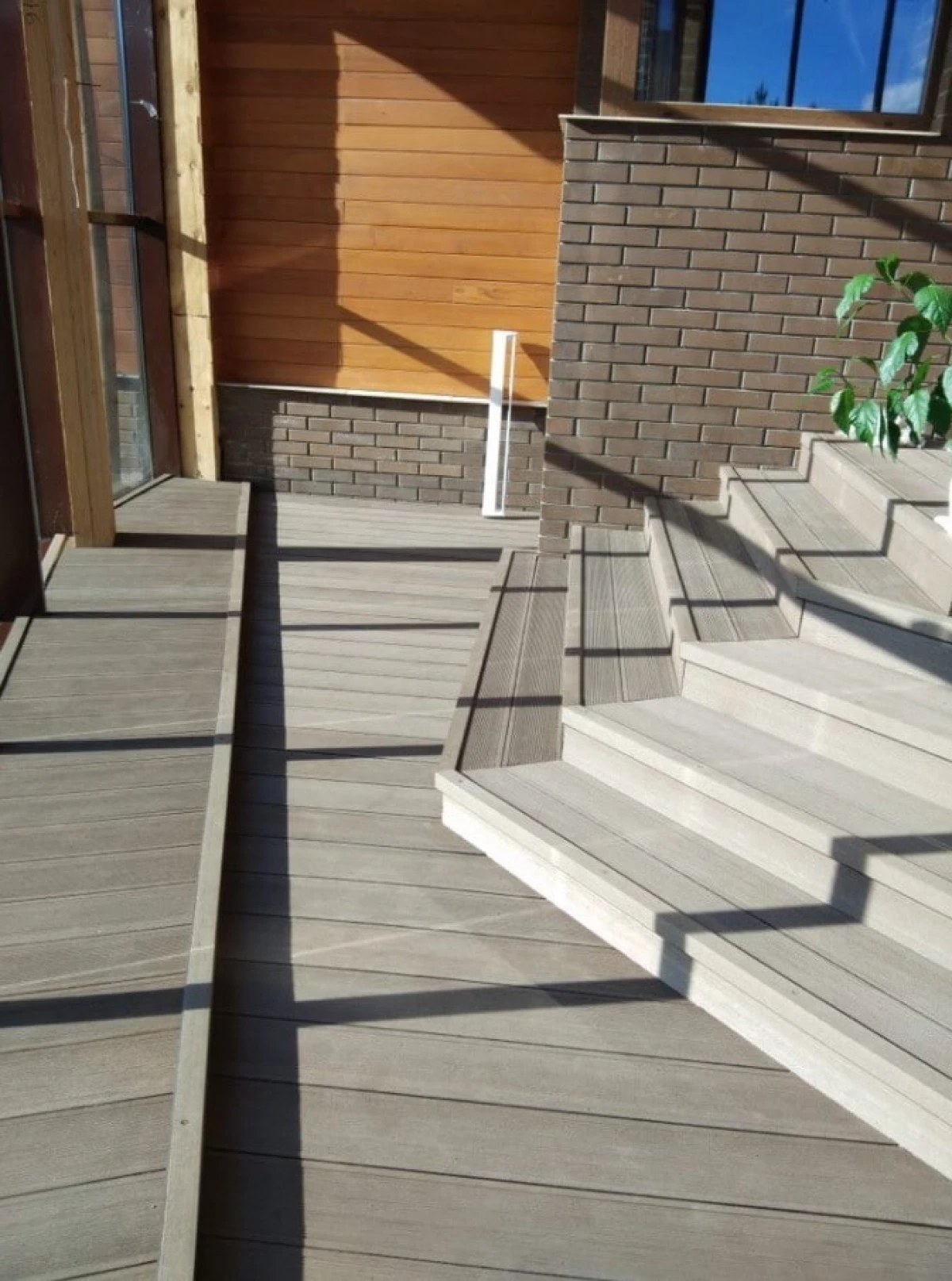
With natural wood, it is still easier: the basis can be painted in anyone! Shada wax, the veil, toned varnish or the most ordinary paint. You can even draw a picture, because the choice is not limited.
It is not necessary to use only one hue - the colors are well combined with each other. For example, make a dark Cant on a light basis or highlight the recreation area different from the main color.
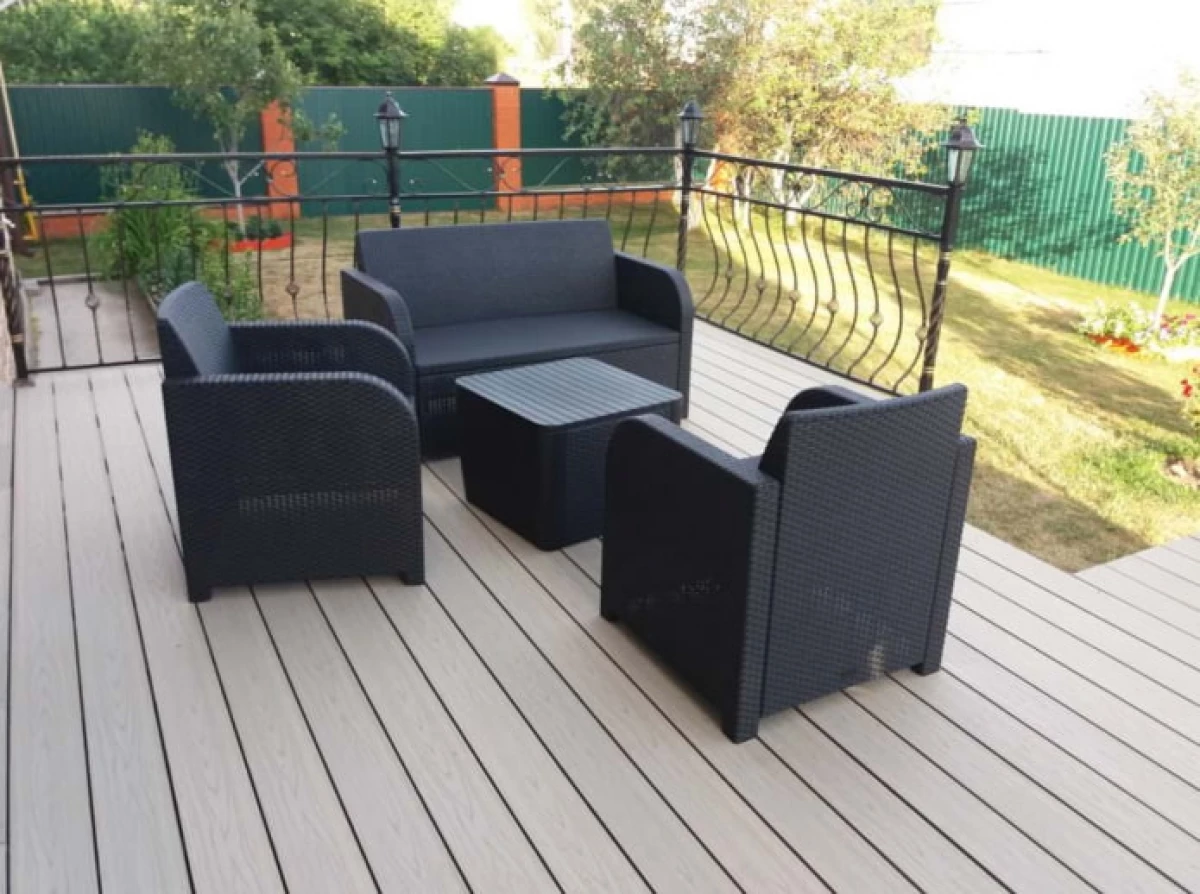
On the photo Light floor of natural material
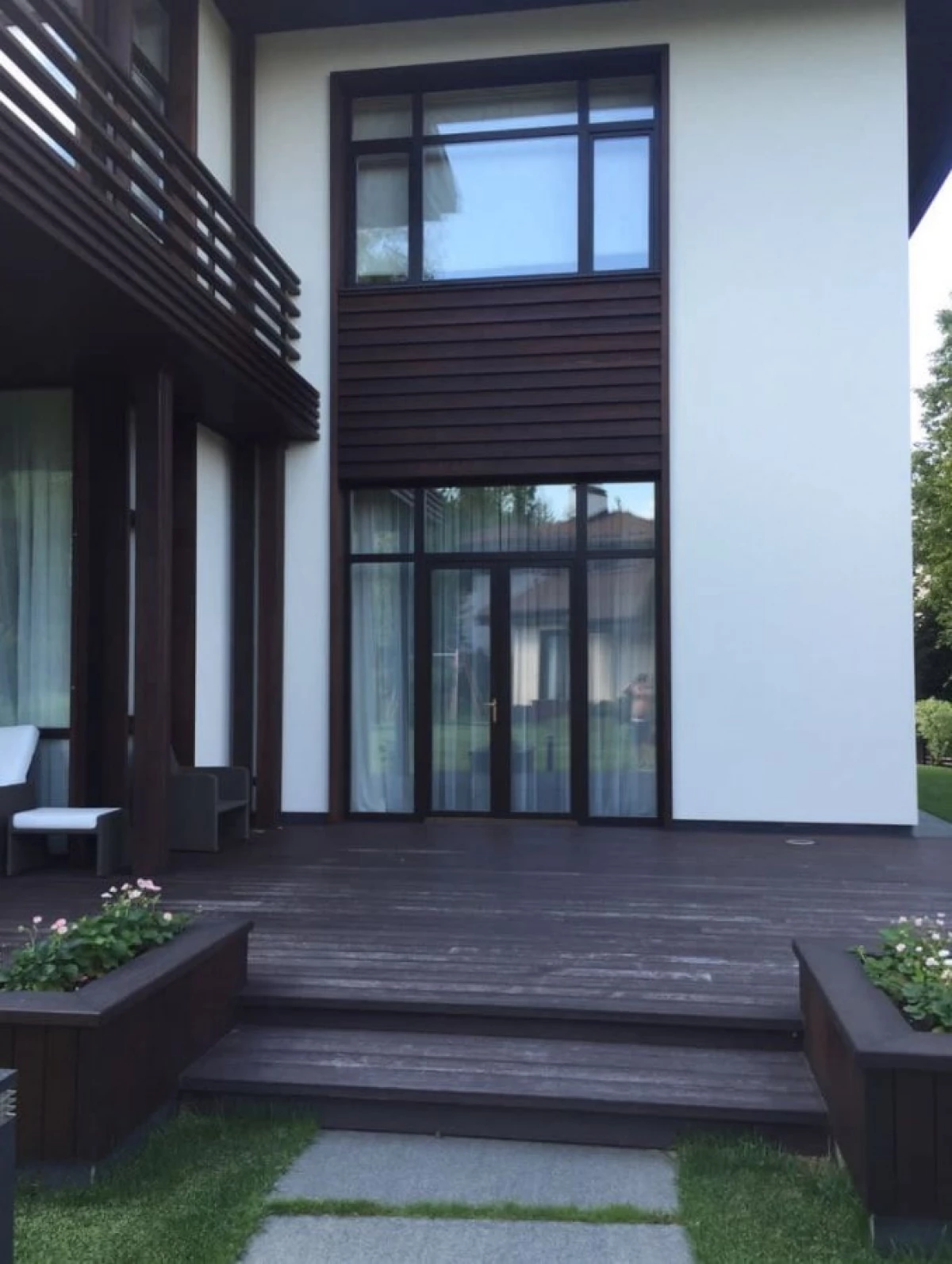
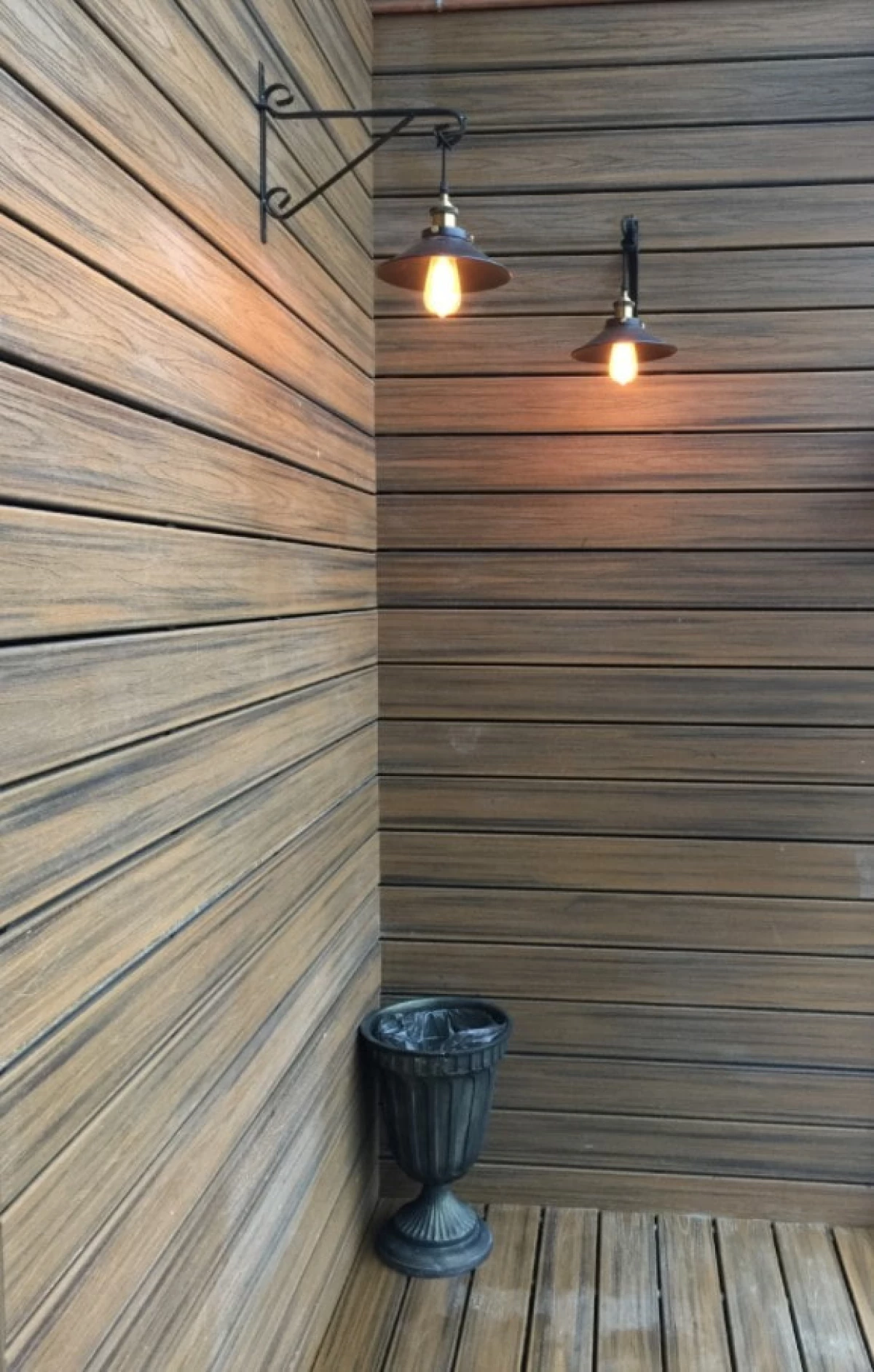
The Council is finally: before buying a board, ask the manufacturer a certificate for this expensive product. So you can make sure that the material and check the necessary characteristics, for example, the minimum temperature or maximum humidity.
